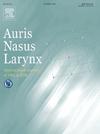组蛋白乙酰转移酶抑制剂抗小鼠中耳胆脂瘤的作用。
IF 1.5
4区 医学
Q2 OTORHINOLARYNGOLOGY
引用次数: 0
摘要
目的:中耳胆脂瘤(简称胆脂瘤)由增生性上皮细胞组成。在之前的研究中,我们证明了与高转录激活相关的组蛋白H3赖氨酸27乙酰化(H3K27ac)在胆脂瘤中积累。在本研究中,我们首先研究了H3K27ac和组蛋白乙酰转移酶p300在人胆脂瘤组织中的表达。然后,我们研究了p300抑制剂C646对胆脂瘤生长的影响。方法:用抗p300和抗h3k27ac抗体对人胆脂瘤标本进行免疫组化分析,用抗p300、抗h3k27ac和抗ki67抗体对p300抑制剂给药后kgf诱导的胆脂瘤小鼠模型进行免疫组化分析。结果:p300在人胆脂瘤组织中表达水平显著升高,并与H3K27ac共定位。此外,在kgf诱导的胆脂瘤小鼠模型中,C646降低了胆脂瘤细胞的增殖活性。结论:我们从一个新的角度证明抑制H3K27ac可能是胆脂瘤的一种潜在治疗策略。本文章由计算机程序翻译,如有差异,请以英文原文为准。
Effect of histone acetyltransferase inhibitor against middle ear cholesteatoma in mouse model
Objective
Middle ear cholesteatoma (Cholesteatoma) consists of proliferative epithelial cells. In the previous study, we demonstrated that histone H3 acetylation at lysine 27 (H3K27ac), associated with high transcriptional activation, was accumulated in the Cholesteatoma. In this study, we firstly investigated the expression of H3K27ac and histone acetyltransferase, p300 in human Cholesteatoma tissues. And then, we investigated the effects of a p300 inhibitor, C646, against Cholesteatoma growth.
Methods
Immunohistochemical analysis was demonstrated in the human Cholesteatoma specimens using anti-p300 and anti-H3K27ac antibodies and in the KGF-induced Cholesteatoma mouse model after p300 inhibitor administration using anti-p300, anti-H3K27ac, and anti-Ki67 antibodies.
Results
The expression levels of p300 were significantly increased and colocalized with H3K27ac in the human Cholesteatoma specimens. Moreover, C646 decreased proliferative activities of Cholesteatoma cells in the KGF-induced Cholesteatoma mouse model.
Conclusion
We demonstrated that inhibition of the H3K27ac may be a potential treatment strategy for Cholesteatoma from a new perspective.
求助全文
通过发布文献求助,成功后即可免费获取论文全文。
去求助
来源期刊

Auris Nasus Larynx
医学-耳鼻喉科学
CiteScore
3.40
自引率
5.90%
发文量
169
审稿时长
30 days
期刊介绍:
The international journal Auris Nasus Larynx provides the opportunity for rapid, carefully reviewed publications concerning the fundamental and clinical aspects of otorhinolaryngology and related fields. This includes otology, neurotology, bronchoesophagology, laryngology, rhinology, allergology, head and neck medicine and oncologic surgery, maxillofacial and plastic surgery, audiology, speech science.
Original papers, short communications and original case reports can be submitted. Reviews on recent developments are invited regularly and Letters to the Editor commenting on papers or any aspect of Auris Nasus Larynx are welcomed.
Founded in 1973 and previously published by the Society for Promotion of International Otorhinolaryngology, the journal is now the official English-language journal of the Oto-Rhino-Laryngological Society of Japan, Inc. The aim of its new international Editorial Board is to make Auris Nasus Larynx an international forum for high quality research and clinical sciences.
 求助内容:
求助内容: 应助结果提醒方式:
应助结果提醒方式:


